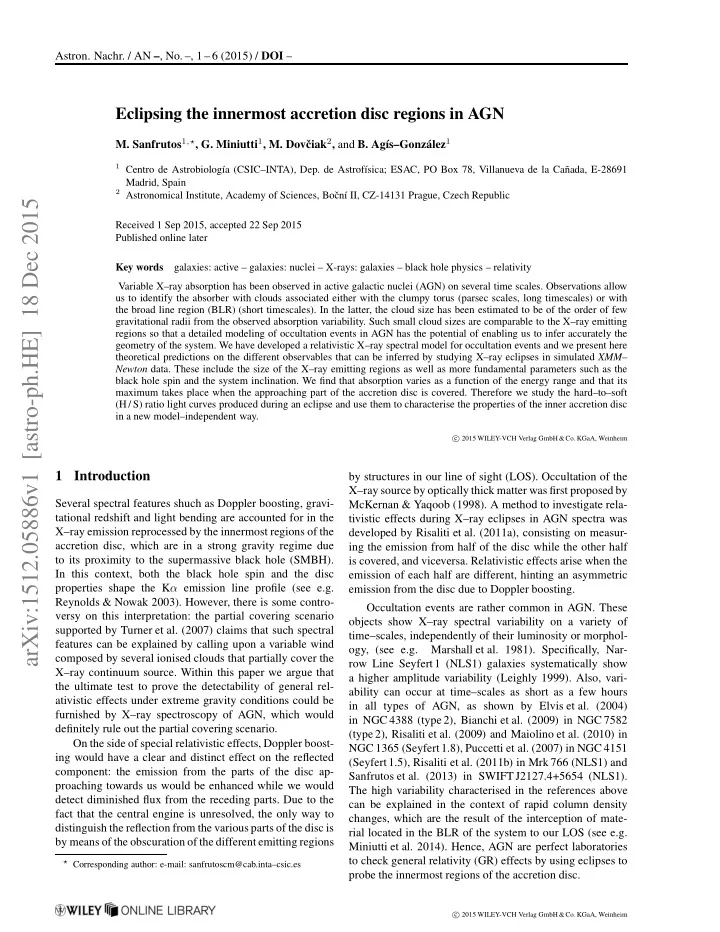

Astron. Nachr. / AN – , No. –, 1 – 6 (2015) / DOI – Eclipsing the innermost accretion disc regions in AGN M. Sanfrutos 1 ,⋆ , G. Miniutti 1 , M. Dovˇ ciak 2 , and B. Ag´ alez 1 ıs–Gonz´ 1 Centro de Astrobiolog´ ıa (CSIC–INTA), Dep. de Astrof´ ısica; ESAC, PO Box 78, Villanueva de la Ca˜ nada, E-28691 Madrid, Spain 2 Astronomical Institute, Academy of Sciences, Boˇ cn´ ı II, CZ-14131 Prague, Czech Republic arXiv:1512.05886v1 [astro-ph.HE] 18 Dec 2015 Received 1 Sep 2015, accepted 22 Sep 2015 Published online later Key words galaxies: active – galaxies: nuclei – X-rays: galaxies – black hole physics – relativity Variable X–ray absorption has been observed in active galactic nuclei (AGN) on several time scales. Observations allow us to identify the absorber with clouds associated either with the clumpy torus (parsec scales, long timescales) or with the broad line region (BLR) (short timescales). In the latter, the cloud size has been estimated to be of the order of few gravitational radii from the observed absorption variability. Such small cloud sizes are comparable to the X–ray emitting regions so that a detailed modeling of occultation events in AGN has the potential of enabling us to infer accurately the geometry of the system. We have developed a relativistic X–ray spectral model for occultation events and we present here theoretical predictions on the different observables that can be inferred by studying X–ray eclipses in simulated XMM– Newton data. These include the size of the X–ray emitting regions as well as more fundamental parameters such as the black hole spin and the system inclination. We find that absorption varies as a function of the energy range and that its maximum takes place when the approaching part of the accretion disc is covered. Therefore we study the hard–to–soft (H / S) ratio light curves produced during an eclipse and use them to characterise the properties of the inner accretion disc in a new model–independent way. � 2015 WILEY-VCH Verlag GmbH & Co. KGaA, Weinheim c 1 Introduction by structures in our line of sight (LOS). Occultation of the X–ray source by optically thick matter was first proposed by Several spectral features shuch as Doppler boosting, gravi- McKernan & Yaqoob (1998). A method to investigate rela- tational redshift and light bending are accounted for in the tivistic effects during X–ray eclipses in AGN spectra was X–ray emission reprocessed by the innermost regions of the developed by Risaliti et al. (2011a), consisting on measur- accretion disc, which are in a strong gravity regime due ing the emission from half of the disc while the other half to its proximity to the supermassive black hole (SMBH). is covered, and viceversa. Relativistic effects arise when the In this context, both the black hole spin and the disc emission of each half are different, hinting an asymmetric properties shape the K α emission line profile (see e.g. emission from the disc due to Doppler boosting. Reynolds & Nowak 2003). However, there is some contro- Occultation events are rather common in AGN. These versy on this interpretation: the partial covering scenario objects show X–ray spectral variability on a variety of supported by Turner et al. (2007) claims that such spectral time–scales, independently of their luminosity or morphol- features can be explained by calling upon a variable wind ogy, (see e.g. Marshall et al. 1981). Specifically, Nar- composed by several ionised clouds that partially cover the row Line Seyfert1 (NLS1) galaxies systematically show X–ray continuum source. Within this paper we argue that a higher amplitude variability (Leighly 1999). Also, vari- the ultimate test to prove the detectability of general rel- ability can occur at time–scales as short as a few hours ativistic effects under extreme gravity conditions could be in all types of AGN, as shown by Elvis et al. (2004) furnished by X–ray spectroscopy of AGN, which would in NGC 4388 (type 2), Bianchi et al. (2009) in NGC 7582 definitely rule out the partial covering scenario. (type 2), Risaliti et al. (2009) and Maiolino et al. (2010) in On the side of special relativistic effects, Doppler boost- NGC 1365 (Seyfert1.8), Puccetti et al. (2007) in NGC 4151 ing would have a clear and distinct effect on the reflected (Seyfert1.5), Risaliti et al. (2011b) in Mrk 766 (NLS1) and component: the emission from the parts of the disc ap- Sanfrutos et al. (2013) in SWIFT J2127.4+5654 (NLS1). proaching towards us would be enhanced while we would The high variability characterised in the references above detect diminished flux from the receding parts. Due to the can be explained in the context of rapid column density fact that the central engine is unresolved, the only way to changes, which are the result of the interception of mate- distinguish the reflection from the various parts of the disc is rial located in the BLR of the system to our LOS (see e.g. by means of the obscuration of the different emitting regions Miniutti et al. 2014). Hence, AGN are perfect laboratories to check general relativity (GR) effects by using eclipses to ⋆ Corresponding author: e-mail: sanfrutoscm@cab.inta–csic.es probe the innermost regions of the accretion disc. � 2015 WILEY-VCH Verlag GmbH & Co. KGaA, Weinheim c
Recommend
More recommend